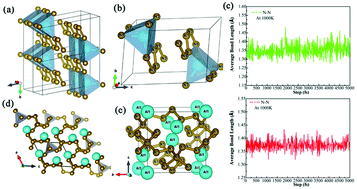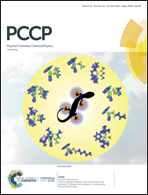Metallic and anti-metallic properties of strongly covalently bonded energetic AlN5 nitrides†
Abstract
High pressure can stimulate numerous novel physical effects which are not observed under ambient conditions, such as the electronic redistribution and delocalization phenomenon in strongly covalently bonded nitrides. Through first principles simulations, we report a new N-rich aluminum nitride AlN5, which crystallizes with the space group P![[1 with combining macron]](https://www.rsc.org/images/entities/char_0031_0304.gif) at 20 GPa and then transforms into the I
at 20 GPa and then transforms into the I![[4 with combining macron]](https://www.rsc.org/images/entities/char_0034_0304.gif) 2d phase at 60 GPa. We have identified and proved the delocalization effects of π electrons in the strongly covalent Lewis poly-nitrogen structure via the one-dimensional particle in a box mechanism, which contributes to the metallization and stability of the system. This implies that not all strongly covalently bonded systems with highly localized electrons exhibit nonmetallic properties in III–V main group nitrides. Furthermore, pressure results in the hybridization configuration mutation from sp2 in the P
2d phase at 60 GPa. We have identified and proved the delocalization effects of π electrons in the strongly covalent Lewis poly-nitrogen structure via the one-dimensional particle in a box mechanism, which contributes to the metallization and stability of the system. This implies that not all strongly covalently bonded systems with highly localized electrons exhibit nonmetallic properties in III–V main group nitrides. Furthermore, pressure results in the hybridization configuration mutation from sp2 in the P![[1 with combining macron]](https://www.rsc.org/images/entities/char_0031_0304.gif) phase to a mixture of sp2 and sp3 hybridization in the I
phase to a mixture of sp2 and sp3 hybridization in the I![[4 with combining macron]](https://www.rsc.org/images/entities/char_0034_0304.gif) 2d phase, which leads to phase transition from metal to insulator. With increasing pressure, the band gap increases abnormally, exhibiting anti-metallization induced by the strong hybridization. Interestingly, the P
2d phase, which leads to phase transition from metal to insulator. With increasing pressure, the band gap increases abnormally, exhibiting anti-metallization induced by the strong hybridization. Interestingly, the P![[1 with combining macron]](https://www.rsc.org/images/entities/char_0031_0304.gif) and I
and I![[4 with combining macron]](https://www.rsc.org/images/entities/char_0034_0304.gif) 2d structures are simultaneously accompanied by a high energy density and hardness, which enable them to have a greater ability to resist elasticity, plastic deformation and external force destruction in potential applications. Their energy density and hardness are up to 3.29 kJ g−1 and 15.2 GPa in the P
2d structures are simultaneously accompanied by a high energy density and hardness, which enable them to have a greater ability to resist elasticity, plastic deformation and external force destruction in potential applications. Their energy density and hardness are up to 3.29 kJ g−1 and 15.2 GPa in the P![[1 with combining macron]](https://www.rsc.org/images/entities/char_0031_0304.gif) phase but especially 6.14 kJ g−1 and 31.7 GPa in the I
phase but especially 6.14 kJ g−1 and 31.7 GPa in the I![[4 with combining macron]](https://www.rsc.org/images/entities/char_0034_0304.gif) 2d phase.
2d phase.



 Please wait while we load your content...
Please wait while we load your content...